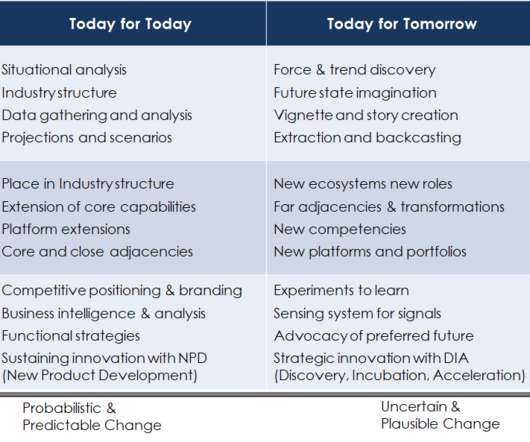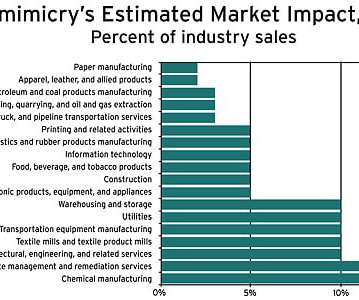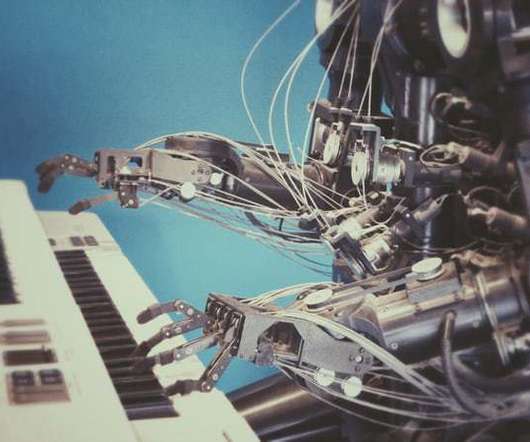You need a red team, not a red pill
Jeffrey Phillips
MAY 24, 2022
Red teams and blue teams originate from the military, where one team takes on the role of an attacker or proposes a strategy and another team seeks to disrupt or destroy the strategy.
This site uses cookies to improve your experience. To help us insure we adhere to various privacy regulations, please select your country/region of residence. If you do not select a country, we will assume you are from the United States. Select your Cookie Settings or view our Privacy Policy and Terms of Use.
Cookies and similar technologies are used on this website for proper function of the website, for tracking performance analytics and for marketing purposes. We and some of our third-party providers may use cookie data for various purposes. Please review the cookie settings below and choose your preference.
Used for the proper function of the website
Used for monitoring website traffic and interactions
Cookies and similar technologies are used on this website for proper function of the website, for tracking performance analytics and for marketing purposes. We and some of our third-party providers may use cookie data for various purposes. Please review the cookie settings below and choose your preference.

Jeffrey Phillips
MAY 24, 2022
Red teams and blue teams originate from the military, where one team takes on the role of an attacker or proposes a strategy and another team seeks to disrupt or destroy the strategy.

Innov8rs
MARCH 3, 2025
Innov8rs | Whilte travelling today is more affordable, accessible and convenient than ever before, the travel industry embraces disruptive technological advancements to meet the growing demand for a better, smoother and personalized travel experience. Innov8rs and Amadeus are co-hosting a 1.5-day
This site is protected by reCAPTCHA and the Google Privacy Policy and Terms of Service apply.
From Rigid To Resilient: Why Enterprises Need Modular Commerce Now
How to Achieve High-Accuracy Results When Using LLMs
Relevance, Reach, Revenue: How to Turn Marketing Trends From Hype to High-Impact

Strategos
MARCH 24, 2017
We are drawn to stories of entrepreneurs who came up with brilliant ideas that disrupted the existing “rules of the game” by which industry players compete with one another. Disruption. A recent report by the Economist showed that 60% of company executives view disruption as a threat rather than an opportunity.

Paul Hobcraft
NOVEMBER 29, 2016
Posted on September 21, 2011. Posted on August 26, 2011. Posted on July 27, 2011. Posted on July 22, 2011. Posted on July 12, 2011. Posted on July 5, 2011. Posted on April 13, 2011. Posted on February 13, 2011. Posted on February 12, 2011. Posted on February 7, 2011.

Daniel Burrus
FEBRUARY 27, 2019
IBM Watson first shot to fame back in 2011 by beating two of Jeopardy’s greatest champions on TV. The post Artificial Intelligence: Disruption or Opportunity? Watson is a cognitive computer that learns over time. This cognitive AI technology can process information much more like a smart human than a smart computer.

Planview
AUGUST 29, 2017
Now, it promises to bring further disruption and fundamentally alter the way businesses grow, manage their finances and most importantly, meet the needs of their customers. billion in 2011 to $20.3 The union of finance and technology has already caused disruption across markets and industries, and that trend is unlikely to go away.

Destination Innovation
MAY 17, 2016
Sales leapt from half a million dollars in 1995 to $17 billion in 2011. Disrupt your own business before someone else does. Bezos diversified his product range first with CDs and videos followed by electronic goods, toys and clothes. In 2013, he purchased The Washington Post newspaper. Lessons for Innovators.

Qmarkets
NOVEMBER 10, 2017
These banks recorded 58% growth between 2011 and 2016, a staggering number – that is until you review the performance of the industry’s newer entrants. Harnessing these people’s industry knowledge, experience and strengths can bring about substantial disruption. The Key to Penetrative Disruption. trillion to $1.0 trillion.

Business and Tech
DECEMBER 16, 2021
At the time we were looking to raise capital (between 2011 and 2013), businesses with women on the executive team received only 7 percent of the venture funding. Since the advancement of technology never stands still, we had to tackle developing major capabilities in a disruptive way while the proverbial clock was ticking.

Paul Hobcraft
JULY 25, 2016
McKinsey in 2011 identified that 72% of transformation programs fail to deliver on their targets so there is an awful lot of thinking, planning and working through any transformation to make sure you end up with the 28% of the success stories. We need to ask can this lead to disruption, ours and others for competitive advantage?

Mills-Scofield
OCTOBER 4, 2015
I am honored to host Whitney Johnson's post as part of the launch of her new book, Disrupt Yourself: Putting the Power of Disruptive Innovation to Work. ~~~~~~~~~~~~~~~~~~~~~~~~~~~~~~~~~~~~~~~~~~~~~~~~~~~~~~~~~~~~~~~~~~~~~~~~~~~~~~~~~~~~. As of 2011, only 26% of teens were employed. Which meant she needed to earn nearly $3,000.

Innovation 360 Group
JUNE 2, 2015
The term first surfaced at the Hannover Messe Industrial Fair in 2011, with the theme Industry 4.0. The post Industry 4.0 – disruption or just a logic extension of WWW? Industry 4.0 is the name of the German government’s strategy for the fourth industrial revolution. So, how do the trends above link to Industry 4.0? Well, in many ways.

Innovation 360
JUNE 2, 2015
The term first surfaced at the Hannover Messe Industrial Fair in 2011, with the theme Industry 4.0. The post Industry 4.0 – disruption or just a logic extension of WWW? Industry 4.0 is the name of the German government’s strategy for the fourth industrial revolution. So, how do the trends above link to Industry 4.0?

Open Innovation EU
SEPTEMBER 6, 2018
New generations, societal change, sustainable goals and disruptive technology require organizations to be much more flexible, self-reinventing organisms that don’t fit above-mentioned design principles. 2015, Christensen, 2011, Birkinshaw & Gibson, 2004, Kelley, 2005). The typology proposes 4 types of organizations.

Paul Hobcraft
MAY 7, 2017
I often write and contribute to many other innovation businesses in different media channels specifically for innovation thought leadership where all my activity has been consistently voted in the top innovation knowledge providers since 2011, something I am incredibly proud to have achieved.

Steve Blank
NOVEMBER 1, 2017
In his Harvard Business Review article summing up his tenure, Immelt recalls that the two things that influenced him most were Marc Andreessen’s 2011 Wall Street Journal article “ Why Software Is Eating the World, ” and Eric Ries’s book The Lean Startup. He doubled GE’s investment in R&D.

Moves the Needle
AUGUST 14, 2018
The idea was conceived by Eric Ries and brought to life in his book The Lean Startup back in 2011. Others are being disrupted. And it’s a good thing, since their current business model is facing massive disruption. Some organizations are adopting lean startup now because they need to create new growth. Competition is now global.

Harvard Business Review
DECEMBER 27, 2011
As 2011 comes to a close, the editors of HBR.org are taking a look back at the most popular blog posts of the year to find out what most preoccupied you, our readers. HBR's 11 Most Popular Blog Posts of 2011. To Get Paid What You're Worth, Know Your Disruptive Skills. Nine Things Successful People Do Differently.

Paul Hobcraft
JULY 25, 2016
McKinsey in 2011 identified that 72% of transformation programs fail to deliver on their targets so there is an awful lot of thinking, planning and working through any transformation to make sure you end up with the 28% of the success stories. We need to ask can this lead to disruption, ours and others for competitive advantage?

Paul Hobcraft
MARCH 15, 2016
I wrote about “ hearing all the voices of ideas at the front end and the “ two distinct parts of the innovation funnel ” building from my original post “ the new extended innovation funnel “, written in 2011. Ideas need to be even more connected both within the organization and outside coming in.

The Inovo Group
MARCH 24, 2019
In 2011, O’Reilly and Tushman [ 3 ] built on the Exploration-Exploitation concept to create what they called the Ambidextrous Organization. And are they sufficient to achieve strategic objectives (or, worse, to avoid disruption)? Without them, species don’t evolve, and they can go extinct. Unfortunately, the answer is usually “no”.

Open Innovation EU
MAY 17, 2017
Whereas Schumpeter describes an entrepreneur as disequilibrative – destroying the pre-existing stage of the equilibrium ((Kirzner, 1999) – Kirzner chooses to describe the role of the entrepreneur as more equilibrative – entrepreneurs systematically displace disruptive conditions in order to create stabilized market conditions (Kirzner, 1999).

Innov8rs
FEBRUARY 1, 2024
Our culture of reinvention enables leaders and businesses to thrive, disrupt, and compete like no other region in the world, so it is the perfect place to host the Innov8rs corporate innovation community,” says Andy Wilson, Executive Director of the Alliance.

Harvard Business Review
DECEMBER 20, 2011
These drivers underpin a number of stories from 2011, but a few new themes came out as well. Coca-Cola was not alone in facing increasing costs in 2011; one of my clients, Kimberly-Clark, took an earnings hit from record pulp prices. Was a year like 2011 possible in a world without climate change? Was a year like 2011 likely ?

Greatest. Idea. Ever.
JANUARY 2, 2021
And just when I was learning the lay of the land a disruptive new trend comes along that could change everything: vTubers. vlogger Ami Yamato, who launched her YouTube channel in late 2011. Before that I never really watched anything on YouTube, not crazy cat videos, Dude Perfect trick shots, unboxing videos, or gaming streams.

The Inovo Group
MAY 14, 2020
By 2011, they had several established stores in the Washington DC area and were ready to expand. In 2011, customers were saying “Wow. The founders desire to create a company that always evolves, that disrupts itself and that is not afraid of experimenting, of trying new things, is stronger than ever.

Planview
SEPTEMBER 23, 2015
But the team at Cambia Health Solutions isn’t convinced that’s the case, which is why they embarked on a collective mission to disrupt and transform the healthcare industry as a whole. The Innovation Force. Enter the Innovation Force, Cambia’s internal innovation program powered by Spigit crowdsourcing software.

Qmarkets
JULY 5, 2017
In 2011, Swiss Post implemented Qmarkets’ full configurable enterprise-grade Q-max innovation software to allow staff from different departments and locations to share new business ideas in an organized, structured environment. But our international involvement goes beyond this.

Qmarkets
DECEMBER 4, 2019
As we can see from these examples (and many more ), studying the solutions which have been developed by animals and plants can be an extremely effective catalyst for the development of disruptive innovations and inventions. Want to Evolve Operational Excellence at Your Enterprise?

Boxes and Arrows
MAY 14, 2013
The iPad hit the market about three years ago, quickly becoming disruptive by creating a user need where there previously was none. iPad App and Website Usability” 2011 : Results from a study. 22% of U.S. adults now own a tablet. Mark Zuckerberg: The iPad Isn’t Mobile” Mashable.com : Next Question. Nielsen, Jakob and Budiu Raluca.

ITONICS
JULY 30, 2018
Disruptive technologies or innovations boost new business models that change the game of existing industries like the space industry (SpaceX), the music industry (Spotify), the film industry (Netflix) or the banking sector (FinTechs), just to name a few. Is there a pattern for disruption & breakthroughs?

Daniel Burrus
JUNE 12, 2019
Over time, this will increasingly disrupt traditional models and global currencies, playing a role in a number of future digital transformations. Litecoin, for example, was launched back in 2011 on the same blockchain as Bitcoin and was meant to improve it. Owning cryptocurrency isn’t analogous to having paper money in your pocket.

hackerearth
SEPTEMBER 15, 2017
Christensen’s theory of disruptive innovation has been called “the most influential business idea of recent years.” Engaging stories and tips on how to deal with damning cynics by donning “suitable” hats make this book an absolute gem. The Innovator's Dilemma by Clayton M. Christensen Renowned Harvard Business School Professor Clayton M.

Christensen Institute
JUNE 8, 2022
We tracked these students’ educational activities from their matriculation in the 2011-2012 school year through the end of 2018. At the end of each piece, we ask one of our education researchers to weigh in on what Theories of Disruptive Innovation have to say about the innovation.

ITONICS
JULY 13, 2018
The startup was founded in 2011 and soon became one of Germany’s fastest-growing tech firms headquartered in Munich, Germany. Celonis, as a software provider, is seeking to disrupt the management consulting sector. The students applied data mining to detect insights and patterns that established companies are struggling to identify.

Boxes and Arrows
FEBRUARY 20, 2018
We wait for two reasons: We want to make sure they have a chance to adequately interact with the product before responding to our survey, and we also want to reduce disruption. Sauro, J (2011). Figure 5 shows the invitation as it appears to the user. Figure 5: The survey invitation in the lower right of this interface. McClelland (Eds.),

Paul Hobcraft
AUGUST 20, 2015
According to a survey by McKinsey in 2011, 72% of our transformation programs fail to deliver on their original targets. Simply put companies ‘die’ due to their inability to adapt to change and transformation projects fail because the message somehow fails to register and never gets completed to the original objectives.

Innovation Excellence
MAY 18, 2020
Clearly, by automating the book buying process, Amazon disrupted superstore book retailers like Barnes & Noble and Borders. Borders filed for bankruptcy in 2011 and was liquidated later that same year. Consider the case of bookstores. Barnes & Noble managed to survive, but has been declining for years.

Qmarkets
JULY 8, 2017
In his 2011 book, Design for Operational Excellence, Kevin J. Make abnormal flow visual so every employee can easily tell when flow has been disrupted. Right Idea, Wrong Approach. In contemporary operations management, the thoughts and feelings of employees are given relatively much more consideration.

Anaqua
MARCH 30, 2018
End of 2011 $1,578. End of 2011 $48 (net of accumulated amortization of $1,114). With the pace of innovation increasing every day, senior executives and Boards need to be mindful of potential risks, including catastrophic disruption; as well as emergent opportunities. End of 2012 $7,473. billion ($2.9 billion cash, $5.5

New Markets Advisors
MAY 17, 2018
With the insights I’ve since gained at New Markets, I’d like to examine the University of Central Asia (UCA) through the lens of disruptive innovation and Jobs to Be Done, two concepts popularized by Clayton Christensen, the author of The Innovator’s Dilemma. The current university system is being disrupted, and this is only the beginning.

IdeaSpies
AUGUST 31, 2018
Books such as Consumptionomics (2011) by Chandran Nair and Abundance: The Future Is Better Than You Think (2012) by Peter H. The New S Curve: Organizations in various countries that I am working with are all buzzing about disruptive innovation – how to build the new growth cycle? Diamandis provide further evidence of this prosperity.

IdeaSpies
FEBRUARY 22, 2019
Books such as Consumptionomics (2011) by Chandran Nair and Abundance: The Future Is Better Than You Think (2012) by Peter H. The New S Curve: Organizations in various countries that I am working with are all buzzing about disruptive innovation – how to build the new growth cycle? Diamandis provide further evidence of this prosperity.

IdeaSpies
FEBRUARY 21, 2019
Books such as Consumptionomics (2011) by Chandran Nair and Abundance: The Future Is Better Than You Think (2012) by Peter H. The New S Curve: Organizations in various countries that I am working with are all buzzing about disruptive innovation – how to build the new growth cycle? A good idea or two will suffice.
Expert insights. Personalized for you.
Are you sure you want to cancel your subscriptions?


Let's personalize your content